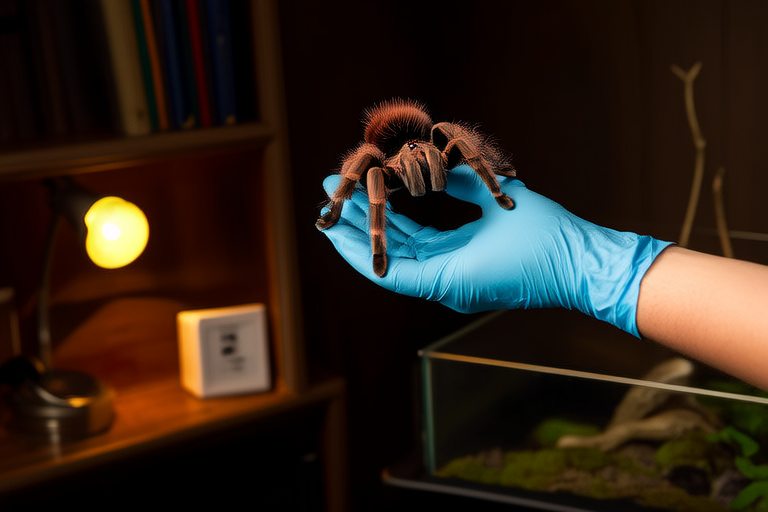Tarantula Handling: Safety Tips and Tricks Every Owner Should Know
Tarantulas, despite their fearsome reputation, are fascinating creatures that make rewarding pets for those willing to meet their unique care requirements. These arachnids are not just a hobby; they require careful handling to ensure both the tarantula’s health and the owner’s safety. Tarantulas are generally docile and can be handled with the right knowledge and precautions. This article will provide a comprehensive guide on safely handling your pet tarantula, covering essential equipment, safety tips, common mistakes to avoid, and ways to build trust between you and your spider.
Introduction: Unique Care Requirements of Tarantulas
Tarantulas have specific needs that set them apart from other pets. They are solitary creatures that prefer minimal interaction. Their habitats must be meticulously maintained to provide the correct humidity levels, temperature, and space for exercise. Handling your tarantula should be done with care and respect for its natural behavior. It is crucial to understand that these spiders are not toys but living beings that require gentle and cautious handling.
Essential Safety Equipment for Handling
Before attempting to handle your tarantula, it is essential to gather the necessary equipment to ensure both your safety and your pet’s well-being. Gloves are recommended for beginners or those who may be nervous about handling the spider directly. They protect against potential bites and allow you to feel more comfortable during the interaction. Additionally, a container or a plastic tub can serve as a safe place to temporarily house your tarantula while you prepare or clean its enclosure. Tongs or forceps can also be useful for moving objects within the enclosure without directly handling the tarantula.
Safety Tips for Handling Your Tarantula
Approaching Your Tarantula
When approaching your tarantula, always move slowly and deliberately. Sudden movements can startle the spider, leading to defensive behaviors such as biting or flicking hairs. Gently extend your hand into the enclosure, allowing the tarantula to see and smell you before making any further moves.
Lifting Your Tarantula
To lift your tarantula, gently scoop it up from underneath using both hands. Support the spider’s body with one hand while securing its legs with the other. Avoid grabbing the spider by its legs or abdomen, as this can cause injury. Once lifted, place the tarantula on a flat surface or in a container. Always support the tarantula’s entire body during the transfer to prevent injury.
Transporting Your Tarantula
If you need to transport your tarantula, use a secure container with ventilation holes. Line the bottom of the container with soft material like tissue paper to cushion the spider. Place the container in a cool, dark area away from vibrations and noise. Ensure that the container is securely closed to prevent escape and keep the tarantula safe during transit.
Common Mistakes Owners Should Avoid
One of the most common mistakes is handling a tarantula too frequently. Tarantulas are solitary animals that do not require regular handling. Overhandling can lead to stress and aggression. Another mistake is not providing a suitable habitat. Insufficient space, incorrect temperature, and humidity levels can cause health problems. Lastly, failing to wash your hands before handling your tarantula can introduce harmful bacteria or chemicals to its environment.
Tricks for Building Trust and Minimizing Stress
Building trust with your tarantula takes time and patience. Start by placing your hand in the enclosure daily, allowing the tarantula to become accustomed to your presence. Gradually increase the amount of time you spend in the enclosure until the tarantula no longer reacts to your presence. You can also offer treats like crickets or mealworms to encourage positive associations. To minimize stress during interactions, always handle your tarantula gently and avoid sudden movements. Keep handling sessions short and end on a positive note.
When to Seek Professional Help
If you notice signs of illness or injury in your tarantula, it is essential to seek professional help. Common signs include lethargy, loss of appetite, unusual behavior, or physical injuries. A veterinarian specializing in exotic animals can diagnose and treat your tarantula effectively. Do not attempt to self-treat your tarantula, as improper treatment can worsen the condition.
In conclusion, handling your tarantula requires careful attention and respect for its unique needs. By following the safety tips and tricks outlined in this article, you can enjoy a rewarding relationship with your pet while ensuring its health and well-being. Remember to approach each interaction with patience and care, and always seek professional help if issues arise.
